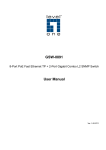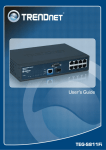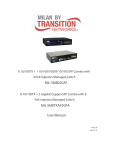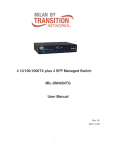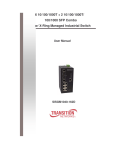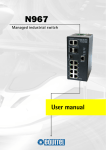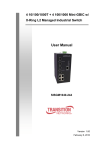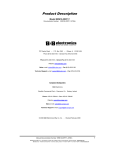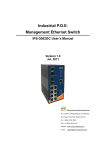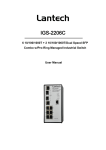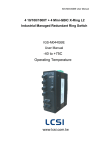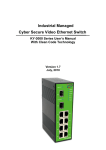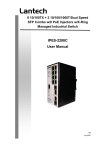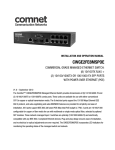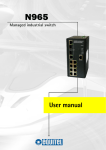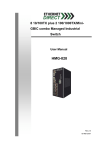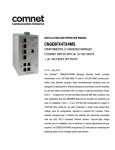Download SM10p-PoE Manual
Transcript
SM10p-PoE 8 (10/100TX) + 2 Gigabit Copper/SFP Combo with 8 PoE Injectors Managed Switch SM10p-PoE Instruction Manual 2012-09 Regulatory Approval - FCC Class A - UL 1950 - CSA C22.2 No. 950 - EN60950 - CE - EN55022 Class A - EN55024 Canadian EMI Notice This Class A digital apparatus meets all the requirements of the Canadian Interference-Causing Equipment Regulations. Cet appareil numerique de la classe A respecte toutes les exigences du Reglement sur le materiel brouilleur du Canada. European Notice Products with the CE Marking comply with both the EMC Directive (89/336/EEC) and the Low Voltage Directive (73/23/EEC) issued by the Commission of the European Community Compliance with these directives imply conformity to the following European Norms: EN55022 (CISPR 22) - Radio Frequency Interference EN61000-X - Electromagnetic Immunity EN60950 (IEC950) - Product Safety FCC Warning This Equipment has been tested and found to comply with the limits for a Class-A digital device, pursuant to Part 15 of the FCC rules. These limits are designed to provide reasonable installation. This energy and, cause harmful guarantee that if protection equipment not against generates installed and interference to interference will radio not harmful uses used in interference and can occur radiate accordance communications. in a in a radio with frequency the instructions, However, particular residential there installation. equipment does cause harmful interference to radio or television reception, which can be determined by turning the equipment off and on, the user is encouraged to try to correct the interference by one or more of the following measures: - Reorient or relocate the receiving antenna. - Increase the separation between the equipment and receiver. - Connect the equipment into an outlet on a circuit different from that to which the receiver is connected. - is Consult the dealer or an experienced radio/TV technician for help. CE Mark Warning This is a Class-A product. In a domestic environment this product may cause radio interference in which case the user may be required to take adequate measures. no If this may Contents FCC Warning ......................................................................................i CE Mark Warning...............................................................................ii Introduction ............................................................................1 Features.............................................................................................. 2 Software Feature ............................................................................... 4 Package Contents............................................................................... 7 Hardware Description ............................................................8 Physical Dimension.......................................................................... .8 Front Panel ....................................................................................... .8 LED Indicators ................................................................................ 10 Rear Panel...................................................................................... ..12 Desktop Installation....................................................................... ..13 Attaching Rubber Pads ...................................................................................13 Power On........................................................................................ .13 Network Application ............................................................14 Small Workgroup ........................................................................... 15 Segment Bridge .............................................................................. 16 Console Management ...........................................................18 Login in the Console Interface.........................................................18 CLI Management ............................................................................ 19 Commands Level ............................................................................................20 Commands Set List .........................................................................................22 System Commands Set.....................................................................................22 Port Commands Set .........................................................................................25 i Trunk Commands Set ............................................................................27 VLAN Commands Set .....................................................................................29 Spanning Tree Commands Set .........................................................................31 QOS Commands Set.........................................................................................33 IGMP Commands Set ......................................................................................34 Mac / Filter Table Commands Set ...................................................................34 SNMP Commands Set .....................................................................................35 Port Mirroring Commands Set .........................................................................38 802.1x Commands Set......................................................................................38 TFTP Commands Set........................................................................................41 SystemLog, SMTP and Event Commands Set.................................................42 SNTP Commands Set ......................................................................................43 X-ring Commands Set .....................................................................................45 Web-Based Management .....................................................46 About Web-based Management...................................................... 46 Preparing for Web Management..................................................... 46 System Login ................................................................................. 46 System Information ........................................................................ 47 IP Configuration ............................................................................. 48 DHCP Configuration ...................................................................... 49 DHCP Server Configuration ...........................................................................50 DHCP Client Entries........................................................................................51 Port and IP Bindings........................................................................................51 TFTP - Update Firmware ................................................................ 52 TFTP - Restore Configuration ........................................................ 53 TFTP - Backup Configuration.......................................................... 53 System Event Log Configuration..................................................... 54 System Event Log - SMTP Configuration ...................................... 55 System Event Log - Event Configuration.........................................56 ii SNTP Configuration ................................................................ 58 IP Security ........................................................................................ 61 User Authentication........................................................................... 62 Port Statistics .................................................................................... 63 Port Control....................................................................................... 64 Port Trunk ......................................................................................... 65 Port Trunk - Aggregator setting ........................................................................65 Port Trunk - Aggregator Information.................................................................66 Port Trunk - State Activity.................................................................................67 Port Mirroring ................................................................................... 68 Rate Limiting..................................................................................... 69 VLAN configuration ......................................................................... 70 VLAN configuration - Port-based VLAN .........................................................71 802.1Q VLAN ...................................................................................................74 802.1Q Configuration.....................................................................................75 Group Configuration .....................................................................................76 Rapid Spanning Tree ........................................................................ 77 RSTP - System Configuration ..........................................................................77 RSTP - Port Configuration................................................................................79 SNMP Configuration ....................................................................... 80 System Configuration ......................................................................................80 Trap Configuration...........................................................................................82 SNMPV3 Configuration ..................................................................................82 QoS Configuration ........................................................................... 86 QoS Policy and Priority Type ..........................................................................86 Port Base Priority ............................................................................................88 COS Configuration ..........................................................................................88 TOS Configuration...........................................................................................88 IGMP Configuration ........................................................................ 88 X-Ring.............................................................................................. 91 iii 802.1X/Radius Configuration ................................................................93 System Configuration ..................................................................................93 802.1x Per Port Configuration .....................................................................94 Misc Configuration ......................................................................................95 MAC Address Table ........................................................................................96 Static MAC Address.....................................................................................96 MAC Filtering .............................................................................................97 All MAC Addresses.....................................................................................98 Power over Ethernet ...................................................................... 100 Factory Default............................................................................... 101 Save Configuration ........................................................................ 102 System Reboot ............................................................................. ..102 Troubleshooting...................................................................103 Incorrect connections .................................................................... 103 Faulty or loose cables................................................................103 Non-standard cables ..................................................................103 Improper Network Topologies...................................................104 Diagnosing LED Indicators............................................................ 104 Technical Specification .......................................................105 Appendix.............................................................................108 Console Port Pin Assignments...................................................... 108 100BASE-TX/10BASE-T Pin Assignments ................................ 109 RJ-45 Pin Assignment of non-802.3af standard PD with Midspan/Endspan POE HUB/SWITCH .....................................................................................109 iv Introduction Power-over-Ethernet (PoE) eliminates the need to run power to other devices on a wired LAN. Using Power-over-Ethernet only a systems installers needs to run single Category 5 Ethernet cable that carries both power and data to each device. This allows for greater flexibility in the location of network devices and significantly decreasing installation costs in many cases. There are initiates the two system components connection to the in second PoE—the component, Power Sourcing and the Equipment Powered (PSE) Device (PD). The current is transmitted over two of the four twisted pairs of wires in a Category-5 cable. Power over Ethernet follows the IEEE 802.3af and is completely compatible with existing Ethernet switches and whether networked (PSE) tests a unless a Powered Device is networked devices. device Because is the Power PoE-capable, Sourcing power is Equipment never transmitted at other end of the cable. It also continues to monitor the channel. If the Powered Device does not draw a minimum current, because it has been unplugged or physically turned off, the PSE shuts down the power to that port. Optionally, the standard permits Powered Devices to signal to the PSEs exactly how much power they need. The 8 10/100TX + 2 Gigabit copper/Mini-GBIC Combo with 8 PoE Injectors Managed Switch and the 8 10/100TX + 1 10/100/1000T/100/1000 SFP Combo with 4 PoE Injectors Managed Switch are the multi-port switches that can be used to build high-performance switched workgroup networks. Both switches are a store-andforward device that offers low latency for high-speed networking. It also features a “store-and-forward “switching scheme. This allows the switch to auto-learn and store source address in an 8K-entry MAC address table. The switch is targeted at workgroup, department or backbone computing environment. 1 Features System Interface/Performance ‹ RJ-45 ports support Auto MDI/MDI-X Function ‹ Embedded 4-port or 8-port PoE injector function ‹ Store-and-Forward Switching Architecture ‹ Back-plane (Switching Fabric): 5.6Gbps (8 10/100TX + 2 Giga Copper/Mini-GBIC Combo model) ‹ Back-plane (Switching Fabric): 3.6Gbps (8 10/100TX + 1 10/100/1000T/100/1000 SFP Combo model) ‹ 1Mbits Packet Buffer ‹ 8K MAC Address Table VLAN ‹ Port Based VLAN ‹ Support 802.1 Q Tag VLAN ‹ GVRP ‹ Double Tag VLAN (Q in Q)* Port Trunk with LACP 8 10/100TX + 2 Giga Copper/Mini-GBIC Combo model supports 802.1ab LLDP** QoS (Quality of Service) ‹ Support IEEE 802.1p Class of Service ‹ Per port provides 4 priority queues ‹ Port Base, Tag Base and Type of Service Priority Port Mirror: Monitor traffic in switched networks. ‹ TX Packet only ‹ RX Packet only ‹ Both of TX and RX Packet Security ‹ Port Security : MAC address entries/filter ‹ IP Security : IP address security management to prevent unauthorized intruder. ‹ Login Security: IEEE802.1X/RADIUS IGMP with Query mode for Multi Media Application 2 Spanning Tree ‹ Support IEEE802.1d Spanning Tree ‹ Support IEEE802.1w Rapid Spanning Tree X-ring ‹ X-ring, Dual Homing, and Couple Ring Topology ‹ Provide redundant backup feature and the recovery time below 300ms Support 802.1ab LLDP ** Bandwidth Control ‹ Ingress Packet Filter and Egress Rate Limit ‹ Broadcast/Multicast Packet Filter Control System Event Log ‹ System Log Server/Client ‹ SMTP e-mail Alert SNMP Trap ‹ Device cold start ‹ Authentication failure ‹ X-ring topology changed ‹ Port Link up/Link down ‹ PoE Status * TFTP Firmware Update and System Configure Restore and Backup * ** Future Release Optional 3 Software Feature Management SNMP v1 SNMP v2c SNMP v3 Web/Telnet/Console (CLI)/Menu Driven** Port based VLAN IEEE802.1Q Tag VLAN(256 entries) / VLAN ID(Up VLAN to 4K, VLAN ID can be assigned from 1 to 4094) GVRP (256 Groups) Double Tag VLAN (Q in Q)* Port Trunk with LACP Port Trunk: 4 trunk groups of maximum 4 LACP trunk members LLDP** Spanning Tree Supports LLDP that allows switch to advertise its identification and capability on the LAN IEEE802.1d Spanning tree IEEE802.1w Rapid spanning tree Supports X-ring, Dual Homing, and Couple Ring X-ring Provides redundant backup feature and recovery time below 300ms Quality of The quality of service determined by port, Tag and service IPv4 Type of service, IPv4/IPv6 Different Service Supports IEEE 802.1p Class of Service, per port Class of Service provides 4 priority queues Weight Round Ratio (WRR)‰ High: Mid-High: Mid-Low: Low (8:4:2:1) 4 Port Security Supports100 entries of MAC address for static MAC and another 100 for MAC filter Supports 3 mirroring types: “RX, TX and Both Port Mirror packet” Supports IGMP snooping v1 and v2 IGMP 256 multicast groups IGMP query mode IP Security Supports 10 IP addresses that have permission to access the switch management to prevent unauthorized intruder Supports ingress packet filter and egress packet limit The egress rate control supports all of packet type and the limit rates are 100Kbps (10/100) and 256Mbps (1000) Bandwidth Control Ingress filter packet type combination rules are Broadcast/Multicast/Unknown Unicast packet, Broadcast/Multicast packet, Broadcast only and all of packet The packet filter rate can be set as 100Kbps (10/100) and 256Mbps (1000) User Authentication Flow Control Supports IEEE802.1x User Authentication and can report to RADIUS server Supports Flow Control for Full-duplex and Back Pressure for Half-duplex 5 System log SMTP Supports System log record and remote system log server Supports SMTP Server and 6 email accounts for receiving event alert Up to 3 Trap stations Cold start, Port link down, Port link up, SNMP Trap authorization failure, PoE status, X-ring topology change DHCP Client DHCP DNS SNTP Firmware Upgrade Configuration Upload and Download * ** DHCP Server Provides DNS client feature and supports Primary and Secondary DNS server Supports Simple Network Time Protocol to synchronize system clock in Internet Supports TFTP firmware upgrade Supports binary format configuration file for system quick installation (TFTP backup and restore) Future Release Optional 6 Package Contents Unpack the contents of the 8 10/100TX + 2 Gigabit copper/Mini-GBIC Combo with 8 PoE Injectors Managed Switch. Verify against the checklist below: - (1) 8 10/100TX + 2 Gigabit copper/Mini-GBIC Combo with 8 PoE Injectors Managed Switch - (4) Rubber Pads - (1) RS-232 cable - (1) Power Cord - (1) User Manual 8 10/100TX plus 2 Gigabit copper/MINI-GBIC Combo with 8 PoE Injectors Managed Rubber Pads RS-232 cable Power Cord User Manual Compare the contents of the package with the standard checklist above. If any item is missing or damaged, please contact the local dealer for exchanging. 7 Hardware Description This section mainly describes the hardware of the PoE Injector Switch and gives a physical and functional overview on the certain switch. Managed Physical Dimension SM10p-PoE 8 10/100TX + 2 Gigabit Injectors Managed Switch’s physical 270mm(W) copper/Mini-GBIC dimensions x 210mm(D) x 44mm(H). 8 is Combo with 8 PoE Front Panel The front panel of the 8 10/100TX + 2 Gigabit copper/Mini-GBIC Injectors Managed Switch consists of 8 x 10/100Base-TX Combo RJ-45 with Ethernet 8 ports (Auto MDI/MDIX), 2 Giga port and 2 Mini-GBIC ports. The LED Indicators are also located on the front panel of the switch. The Front panel of the 8 10/100TX + 2 Gigabit copper/Mini-GBIC Combo with 8 PoE Injectors Managed Switch - RJ-45 Ports: 8 x 10/100 N-way auto-sensing for 10Base-T or 100Base-TX connections. Moreover, these ports also supply power for PDs. In general, MDI MDIX means connecting MDI/MDIX changing - means connecting to another Hub would to a or Switch workstation or PC. Therefore, Auto or crossover cabling. 2 Gigabit Ethernet port: 2 x 10/100/1000TX N-Way auto-sensing for 10/100/1000 connection. - while allow connecting to another switch or workstation without non-crossover 2 Mini-GBIC port: 2 mini-GBIC ports for Gigabit or 100M fiber connection. 9 PoE LED Indicators The LED Indicators display real-time information of systematic operation The following table provides descriptions of LED status and their meaning. The LED indicators description of 8 10/100TX + 2 Gigabit Copper/Mini-GBIC Combo model LED Power Status Description Green Power On OFF No power inputs The port is supplying power to the connected powered-device Green No powered device attached or power FWD (port 1~8) OFF supplying failed The port is operating at speed of 1000M Green 1000M (RJ45 port 9~10) OFF The port is disconnected or not operating at speed of 1000M Connected to network Green Networking is active Blinking LK/ACT (port 1~ 10) Not connected to network OFF The port is operating at speed of 100M Green The port is disconnected or not operating 100M OFF at speed of 100M 10 status. LK/ACT Green Connected to network Blinking Networking is active OFF Not connected to network (MINI GBIC 9, 10) 11 Rear Panel The 3-pronged power plug and terminal block are located on the rear panel 10/100TX + 2 Gigabit copper/Mini-GBIC Combo with 8 PoE Injectors Managed Switch as shown The switch will work with AC in the voltage range of AC of below. 100-240V with Frequency of 50-60Hz, or work with DC 48V which is the redundant power supply for the switch. The Rear Panel of the 8 10/100TX + 2 Gigabit copper/ MINI GBIC Combo with 8 PoE Injector Managed Switch 12 the 8 Desktop Installation Set the switch on a sufficiently large flat space with a power outlet nearby. The surface where you put the switch should be clean, smooth, level and sturdy. Make sure there is enough clearance around the switch to allow attachment of cables, power cord and allow air circulation. Attaching Rubber Pads A. Make sure mounting surface on the bottom of the switch is grease and dust free. B. Remove adhesive backing from your Rubber Pads. C. Apply the Rubber Pads to each corner on the bottom of the switch. These footpads can prevent the switch from shock/vibration. Power On Connect the power cord to the power socket on the rear panel of the switch. The other side of power cord connects to the power outlet. The internal power supply of the switch works with voltage range of AC in the 100-240VAC/ Frequency of 50~60Hz, or redundant power of DC 48V for 8 10/100TX + 2 Gigabit copper/Mini-GBIC Combo with 8 PoE Injectors Managed Switch. Check the power is properly supplied. 13 power indicator on the front panel to see if the Network Application This section provides a few samples of network topology in which the switch is used. In general, the PoE Injector Managed Switch is designed as a segment switch which has large address table (8k MAC addresses) and high performance to deal with interconnecting networking segments. PC, workstations, and servers can communicate each other by directly connecting with PoE injector Managed Switch. The switch automatically learns nodes addresses, which are subsequently used to filter and forward all traffic based on the destination address. Using the uplink port (Giga Combo port), the switch can connect with another switch or hub to interconnect other small-switched workgroups to form a larger switched network. Meanwhile, injects user power can into also use the UTP fiber cables ports for to connect supplying switches. the power The that PoE switch PDs (Power also Devices) need. The Power over Ethernet Switch can provide power to PDs that follow the IEEE 802.3af standard in the network. It can devices can be installed in more solve the appropriate problem position of position for better limitation. The performance. following figure is an example of network application for Power over Ethernet Switch. 14 network The Power over Ethernet Switch network application Small Workgroup The PoE Injector Managed Switch can be used as a standalone switch to which personal computers, server, printer server, are directly connected to form a small workgroup. 15 Small Workgroup application Segment Bridge For enterprise networks where large data broadcasts are constantly processed, this switch is an ideal solution for department users to connect to the corporate backbone. In the illustration below, two Ethernet switches attached, are communicate both with connected each other to the with PCs, print server, and local server switch. through the switch. allows other users to access the data on server. 16 All the devices Connecting in this servers network to the can switch Segment Bridge application 17 Console Management Login in the Console Interface When the connection between switch and PC is ready, turn on the PC and run a terminal emulation program or Hyper Terminal and configure its communication parameters to match the following default characteristics of the console port: Baud Rate: 9600 bps Data Bits: 8 Parity: none Stop Bit: 1 Flow control: None The settings of communication parameters After finishing the parameter settings, screen shows click “OK“. When the blank up, press Enter key to bring out the login prompt. Key in the ‘root’ (default value) for both User name and Password (use Enter key to toggle), then hit Enter key and the console management appears right after. Please see the figure below for login screen. 18 Console login screen CLI Management The system system, you supports will see console a management command prompt. – CLI command. After you login to the To enter CLI management “enable” command. The following table lists the CLI commands and description. 19 interface, enter CLI command interface Commands Level Access Modes Exit Prompt Method About This Mode1 Method The user commands available at the user level are a subset of Begin a User EXEC session with switch> your switch. Enter those available at the logout or privileged level. quit. Use this mode to • Perform basic tests. • Display system information. Privileged Enter the enable EXEC command Enter switch# disable to exit. while in user The privileged command is in advanced mode Privileged this mode 20 EXEC mode. to • Display advanced function status • Save configuration Enter the Global Configura tion configure To exit to privileged Use this mode to command switch EXEC configure parameters while in (config)# mode, that apply to your privileged enter exit or switch as a whole. EXEC mode. end Enter the vlan database To exit to Use this mode to VLAN command switch user EXEC configure database while in (vlan)# mode, VLAN-specific enter exit. parameters. privileged EXEC mode. To exit to Interface configurat ion Enter the global interface configuratio n mode, command (with a specific interface) while in global switch (config-if) # enter exit. Use this mode to configure parameters To exist to for the switch and privileged Ethernet ports. configuration EXEC mode mode, or end. 21 Commands Set List User EXEC E Privileged EXEC P Global configuration G VLAN database V Interface configuration I System Commands Set Commands Level Description show config E Show switch Example switch>show config configuration show terminal P Show console switch#show terminal information write memory P Save user switch#write memory configuration into permanent memory (flash rom) system name G [System Name] system location G G [System Description] system contact G [System Contact] show system-info switch(config)#system name xxx name [System Location] system description Configure system Set switch system switch(config)#system location location string xxx Set switch system switch(config)#system description string description xxx Set switch system switch(config)#system contact contact window string xxx E Show system switch>show system-info information ip address [Ip-address] G Configure the IP switch(config)#ip address address of switch 192.168.16.1 255.255.255.0 [Subnet-mask] 192.168.16.254 22 [Gateway] ip dhcp G Enable DHCP client switch(config)#ip dhcp function of switch show ip P Show IP information of switch#show ip switch no ip dhcp G Disable DHCP client switch(config)#no ip dhcp function of switch reload G Halt and perform a cold restart switch(config)#reload default G Restore to default switch(config)#default admin username G Changes a login switch(config)#admin username username. xxxxxx [Username] (maximum 10 words) admin password G [Password] show admin P Specifies a password switch(config)#admin password (maximum 10 words) xxxxxx Show administrator switch#show admin information dhcpserver enable G Enable DHCP Server switch(config)#dhcpserver enable Dhcpserver disable G Disable DHCP Server switch(config)#no dhcpserver dhcpserver lowip G Configure low IP switch(config)#dhcpserver lowip address for IP pool 192.168.1.100 Configure high IP switch(config)#dhcpserver highip address for IP pool 192.168.1.200 Configure subnet switch(config)#dhcpserver [Low IP] dhcpserver highip G [High IP] dhcpserver subnetmask G [Subnet mask] dhcpserver gateway mask for DHCP clients subnetmask 255.255.255.0 G [Gateway] dhcpserver dnsip G [DNS IP] dhcpserver leasetime G [Hours] dhcpserver ipbinding I Configure gateway for switch(config)#dhcpserver DHCP clients gateway 192.168.1.254 Configure DNS IP for switch(config)#dhcpserver dnsip DHCP clients 192.168.1.1 Configure lease time switch(config)#dhcpserver (in hour) leasetime 1 Set static IP for DHCP 23 switch(config)#interface [IP address] clients by port fastEthernet 2 switch(config)#dhcpserver ipbinding 192.168.1.1 show dhcpserver P configuration show dhcpserver clients P Show configuration of switch#show dhcpserver DHCP server configuration Show client entries of switch#show dhcpserver clients DHCP server show dhcpserver P ip-binding Show IP-Binding switch#show dhcpserver information of DHCP ip-binding server no dhcpserver G Disable DHCP server switch(config)#no dhcpserver function security enable G Enable IP security switch(config)#security enable function security http G Enable IP security of switch(config)#security http HTTP server security telnet G Enable IP security of switch(config)#security telnet telnet server security ip G Set the IP security list switch(config)#security ip 1 [Index(1..10)] [IP 192.168.1.55 Address] show security P Show the information switch#show security of IP security no security G Disable IP security switch(config)#no security function no security http G Disable IP security of switch(config)#no security http HTTP server no security telnet G Disable IP security of telnet server 24 switch(config)#no security telnet Port Commands Set Commands interface fastEthernet Level G [Portid] duplex I [full | half] Description Example Choose the port for switch(config)#interface modification. fastEthernet 2 Use the duplex switch(config)#interface configuration fastEthernet 2 command to specify switch(config-if)#duplex full the duplex mode of operation for Fast Ethernet. speed [10|100|1000|auto] I Use the speed switch(config)#interface configuration fastEthernet 2 command to specify switch(config-if)#speed 100 the speed mode of operation for Fast Ethernet., the speed can’t be set to 1000 if the port isn’t a giga port.. no flowcontrol I Disable flow control of switch(config-if)#no flowcontrol interface security enable I Enable security of switch(config)#interface interface fastEthernet 2 switch(config-if)#security enable no security I Disable security of switch(config)#interface interface fastEthernet 2 switch(config-if)#no security bandwidth type all I Set interface ingress switch(config)#interface limit frame type to fastEthernet 2 ‘accept all frame’ switch(config-if)#bandwidth type all 25 bandwidth type Set interface ingress switch(config)#interface broadcast-multicast-floo limit frame type to fastEthernet 2 ded-unicast ‘accept broadcast, switch(config-if)#bandwidth type multicast, and flooded broadcast-multicast-flooded-uni unicast frame’ cast Set interface ingress switch(config)#interface limit frame type to fastEthernet 2 bandwidth type I I broadcast-multicast ‘accept broadcast and switch(config-if)#bandwidth type bandwidth type I broadcast-only bandwidth in multicast frame’ broadcast-multicast Set interface ingress switch(config)#interface limit frame type to ‘only fastEthernet 2 I [Value] accept broadcast switch(config-if)#bandwidth type frame’ broadcast-only Set interface input switch(config)#interface bandwidth. Rate fastEthernet 2 Range is from 100 switch(config-if)#bandwidth in 100 kbps to 102400 kbps or to 256000 kbps for giga ports, and zero means no limit. bandwidth out Set interface output switch(config)#interface [Value] bandwidth. Rate fastEthernet 2 Range is from 100 switch(config-if)#bandwidth out kbps to 102400 kbps 100 or to 256000 kbps for giga ports, and zero means no limit. show bandwidth I Show interfaces bandwidth control switch(config)#interface fastEthernet 2 switch(config-if)#show bandwidth 26 state I [Enable | Disable] Use the state interface switch(config)#interface configuration command to fastEthernet 2 switch(config-if)#state Disable specify the state mode of operation for Ethernet ports. Use the disable form of this command to disable the port. show interface configuration I show interface configuration status switch(config)#interface fastEthernet 2 switch(config-if)#show interface configuration show interface status I show interface actual switch(config)#interface status fastEthernet 2 switch(config-if)#show interface status show interface I accounting show interface statistic switch(config)#interface counter fastEthernet 2 switch(config-if)#show interface accounting no accounting I Clear interface switch(config)#interface accounting information fastEthernet 2 switch(config-if)#no accounting Trunk Commands Set Commands aggregator priority Level G [1~65535] aggregator activityport G Description Example Set port group system switch(config)#aggregator priority priority 22 Set activity port switch(config)#aggregator [Group ID] activityport 2 [Port Numbers] aggregator group G Assign a trunk group 27 switch(config)#aggregator group [GroupID] [Port-list] with LACP active. 1 1-4 lacp workp 2 lacp [GroupID] :1~4 or workp [Port-list]:Member port [Workport] list, This parameter switch(config)#aggregator group 2 1,4,3 lacp workp 3 could be a port range(ex.1-4) or a port list separate by a comma(ex.2, 3, 6) [Workport]: The amount of work ports, this value could not be less than zero or be large than the amount of member ports. aggregator group [GroupID] [Port-list] G nolacp Assign a static trunk group. switch(config)#aggregator group 1 2-4 nolacp [GroupID] :1~4 or [Port-list]:Member port list, This parameter switch(config)#aggregator group 1 3,1,2 nolacp could be a port range(ex.1-4) or a port list separate by a comma(ex.2, 3, 6) show aggregator P Show the information switch#show aggregator 1 of trunk group or switch#show aggregator 2 or switch#show aggregator 3 no aggregator lacp G [GroupID] no aggregator group [GroupID] Disable the LACP switch(config)#no aggreator lacp function of trunk group 1 G Remove a trunk group 28 switch(config)#no aggreator group 2 VLAN Commands Set Commands vlan database Level P Description Example Enter VLAN configure switch#vlan database mode Vlanmode V [portbase| 802.1q | To set switch VLAN switch(vlan)#vlanmode portbase mode. or gvrp] switch(vlan)#vlanmode 802.1q or switch(vlan)#vlanmode gvrp no vlan V No VLAN Switch(vlan)#no vlan Add new port based switch(vlan)#vlan port-based VALN grpname test grpid 2 port 2-4 Ported based VLAN configuration vlan port-based V grpname [Group Name] or grpid switch(vlan)#vlan port-based [GroupID] grpname test grpid 2 port 2,3,4 port [PortNumbers] show vlan [GroupID] or show vlan no vlan group [GroupID] switch(vlan)#show vlan 23 V Show VLAN information V Delete port base group switch(vlan)#no vlan group 2 ID IEEE 802.1Q VLAN vlan 8021q name [GroupName] vid [VID] V Change the name of switch(vlan)#vlan 8021q name VLAN group, if the test vid 22 group didn’t exist, this command can’t be applied. vlan 8021q port [PortNumber] access-link untag [UntaggedVID] V Assign a access link switch(vlan)#vlan 8021q port 3 for VLAN by port, if the access-link untag 33 29 port belong to a trunk group, this command can’t be applied. vlan 8021q port [PortNumber] trunk-link tag [TaggedVID List] vlan 8021q port [PortNumber] hybrid-link untag [UntaggedVID] tag [TaggedVID List] V V vlan 8021q trunk [PortNumber] access-link untag [UntaggedVID] V vlan 8021q trunk [PortNumber] trunk-link tag V Assign a trunk link for switch(vlan)#vlan 8021q port 3 VLAN by port, if the trunk-link tag 2,3,6,99 port belong to a trunk or group, this command switch(vlan)#vlan 8021q port 3 can’t be applied. trunk-link tag 3-20 Assign a hybrid link for switch(vlan)#vlan 8021q port 3 VLAN by port, if the hybrid-link untag 4 tag 3,6,8 port belong to a trunk or group, this command switch(vlan)#vlan 8021q port 3 can’t be applied. hybrid-link untag 5 tag 6-8 Assign a access link switch(vlan)#vlan 8021q trunk 3 for VLAN by trunk access-link untag 33 group Assign a trunk link for switch(vlan)#vlan 8021q trunk 3 VLAN by trunk group trunk-link tag 2,3,6,99 or [TaggedVID List] switch(vlan)#vlan 8021q trunk 3 trunk-link tag 3-20 vlan 8021q trunk [PortNumber] hybrid-link untag [UntaggedVID] tag [TaggedVID List] V Assign a hybrid link for switch(vlan)#vlan 8021q trunk 3 VLAN by trunk group hybrid-link untag 4 tag 3,6,8 or switch(vlan)#vlan 8021q trunk 3 hybrid-link untag 5 tag 6-8 show vlan [GroupID] or show vlan no vlan group [GroupID] V Show VLAN switch(vlan)#show vlan 23 information V Delete port base group switch(vlan)#no vlan group 2 ID 30 Spanning Tree Commands Set Commands spanning-tree enable Level G Description Example Enable spanning tree switch(config)#spanning-tree enable spanning-tree priority G [0~61440] spanning-tree max-age G [seconds] Configure spanning switch(config)#spanning-tree tree priority parameter priority 32767 Use the spanning-tree switch(config)#spanning-tree max-age global max-age 15 configuration command to change the interval between messages the spanning tree receives from the root switch. If a switch does not receive a bridge protocol data unit (BPDU) message from the root switch within this interval, it recomputed the Spanning Tree Protocol (STP) topology. spanning-tree G hello-time [seconds] Use the spanning-tree switch(config)#spanning-tree hello-time global hello-time 3 configuration command to specify the interval between hello bridge protocol data units (BPDUs). spanning-tree G Use the spanning-tree switch(config)#spanning-tree 31 forward-time [seconds] forward-time global forward-time 20 configuration command to set the forwarding-time for the specified spanning-tree instances. The forwarding time determines how long each of the listening and stp-path-cost I [1~200000000] learning states last before the port begins forwarding. Use the spanning-tree switch(config)#interface cost interface fastEthernet 2 configuration switch(config-if)#stp-path-cost 20 command to set the path cost for Spanning Tree Protocol (STP) calculations. In the event of a loop, spanning tree considers the path cost when selecting an interface to place into the forwarding state. stp-path-priority [Port Priority] I Use the spanning-tree switch(config)#interface port-priority interface fastEthernet 2 configuration switch(config-if)#stp-path-priority command to configure 128 32 a port priority that is used when two switches tie for position as the root switch. stp-admin-p2p I [Auto|True|False] Admin P2P of STP switch(config)#interface priority on this fastEthernet 2 interface. switch(config-if)#stp-admin-p2p Auto stp-admin-edge I [True|False] Admin Edge of STP switch(config)#interface priority on this fastEthernet 2 interface. switch(config-if)#stp-admin-edge True stp-admin-non-stp I [True|False] Admin NonSTP of STP switch(config)#interface priority on this fastEthernet 2 interface. switch(config-if)#stp-admin-non-s tp False show spanning-tree E Displays a summary of switch>show spanning-tree the spanning-tree states. no spanning-tree G Disable spanning-tree. switch(config)#no spanning-tree QOS Commands Set Commands Level qos policy G [weighted-fair|strict] qos prioritytype G [port-based|cos-only|tos Description Example Select QOS policy switch(config)#qos policy scheduling weighted-fair Setting of QOS priority switch(config)#qos prioritytype type -only|cos-first|tos-first] qos priority portbased [Port] [lowest|low|middle|high] G Configure Port-based switch(config)#qos priority Priority portbased 1 low 33 qos priority cos [Priority][lowest|low|mid dle|high] qos priority tos G Configure COS Priority switch(config)#qos priority cos 0 middle G Configure TOS Priority switch(config)#qos priority tos 3 high P Displays the [Priority][lowest|low|mid dle|high] show qos Switch#show qos information of QoS configuration no qos G Disable QoS function switch(config)#no qos IGMP Commands Set Commands Level Description igmp enable G Enable IGMP Example switch(config)#igmp enable snooping function Igmp-query auto G Set IGMP query to switch(config)#Igmp-query auto auto mode Igmp-query force G Set IGMP query to switch(config)#Igmp-query force force mode show igmp P Displays the details of switch#show igmp configuration an IGMP configuration configuration. show igmp multi P Displays the details of switch#show igmp multi an IGMP snooping entries. no igmp G Disable IGMP switch(config)#no igmp snooping function no igmp-query G Disable IGMP query switch#no igmp-query Mac / Filter Table Commands Set Commands mac-address-table static Level I Description Configure MAC 34 Example switch(config)#interface hwaddr address table of fastEthernet 2 [MAC] interface (static). switch(config-if)#mac-address-tab le static hwaddr 000012345678 mac-address-table filter G hwaddr Configure MAC switch(config)#mac-address-table address table(filter) filter hwaddr 000012348678 [MAC] show mac-address-table P Show all MAC address switch#show mac-address-table table show mac-address-table P static P show mac-address-table filter no mac-address-table I Show static MAC switch#show mac-address-table address table static Show filter MAC switch#show mac-address-table address table. filter Remove an entry of switch(config)#interface static hwaddr MAC address table of fastEthernet 2 [MAC] interface (static) switch(config-if)#no mac-address-table static hwaddr 000012345678 Remove an entry of switch(config)#no filter hwaddr MAC address table mac-address-table filter hwaddr [MAC] (filter) 000012348678 no mac-address-table G G no mac-address-table Remove dynamic entry switch(config)#no of MAC address table mac-address-table SNMP Commands Set Commands snmp system-name Level G [System Name] snmp system-location G [System Location] snmp system-contact [System Contact] G Description Example Set SNMP agent switch(config)#snmp system name system-name l2switch Set SNMP agent switch(config)#snmp system location system-location lab Set SNMP agent switch(config)#snmp system contact system-contact where 35 snmp agent-mode G [v1v2c|v3|v1v2cv3] snmp G community-strings Select the agent mode switch(config)#snmp agent-mode of SNMP v1v2cv3 Add SNMP community switch(config)#snmp string. community-strings public right rw [Community] right [RO/RW] snmp-server host G Configure SNMP switch(config)#snmp-server host [IP address] server host information 192.168.1.50 community public community and community string trap-version v1 [Community-string] (remove) trap-version Switch(config)# [v1|v2c] no snmp-server host 192.168.1.50 Configure the context switch(config)#snmpv3 name context-name Test Configure the switch(config)#snmpv3 user [User Name] userprofile for test01 group G1 password group SNMPV3 agent. AuthPW PrivPW [Group Name] Privacy password password could be empty. snmpv3 context-name G [Context Name ] snmpv3 user G [Authentication Password] [Privacy Password] snmpv3 access G Configure the access context-name [Context table of SNMPV3 switch(config)#snmpv3 access context-name Test group G1 Name ] agent security-level AuthPriv match-rule Exact views V1 V1 V1 group [Group Name ] security-level [NoAuthNoPriv|AuthNoP riv|AuthPriv] 36 match-rule [Exact|Prifix] views [Read View Name] [Write View Name] [Notify View Name] snmpv3 mibview view G Configure the mibview switch(config)#snmpv3 mibview [View Name] table of SNMPV3 view V1 type Excluded sub-oid type agent 1.3.6.1 Show SNMP switch#show snmp [Excluded|Included] sub-oid [OID] show snmp P configuration no snmp G Remove the specified community-strings switch(config)#no snmp community. community-strings public Remove the SNMP switch(config)#no snmp-server server host. 192.168.1.50 [Community] no snmp-server host G [Host-address] no snmpv3 user G [User Name] Remove specified user switch(config)#no snmpv3 user of SNMPv3 agent. Test Remove specified switch(config)#no snmpv3 access context-name [Context access table of context-name Test group G1 Name ] SNMPv3 agent. security-level AuthPr no snmpv3 access G group iv match-rule Exact views V1 V1 [Group Name ] V1 security-level [NoAuthNoPriv|AuthNoP riv|AuthPriv] match-rule [Exact|Prifix] views 37 [Read View Name] [Write View Name] [Notify View Name] no snmpv3 mibview G view Remove specified mibview table of switch(config)#no snmpv3 mibview view V1 type Excluded [View Name] SNMPV3 agent. sub-oid 1.3.6.1 type [Excluded|Included] sub-oid [OID] Port Mirroring Commands Set Commands Level monitor rx G Description Set RX destination Example switch(config)#monitor rx port of monitor function G monitor tx Set TX destination port switch(config)#monitor tx of monitor function show monitor P Show port monitor switch#show monitor information monitor I Configure source port switch(config)#interface of monitor function [RX|TX|Both] fastEthernet 2 switch(config-if)#monitor RX show monitor I Show port monitor switch(config)#interface information fastEthernet 2 switch(config-if)#show monitor no monitor I Disable source port of switch(config)#interface monitor function fastEthernet 2 switch(config-if)#no monitor 802.1x Commands Set Commands Level Description 38 Example 8021x enable G Use the 802.1x global switch(config)# 8021x enable configuration command to enable 802.1x protocols. 8021x system radiusip G [IP address] Use the 802.1x system switch(config)# 8021x system radius IP global radiusip 192.168.1.1 configuration command to change the radius server IP. 8021x system serverport G [port ID] Use the 802.1x system switch(config)# 8021x system server port global serverport 1815 configuration command to change the radius server port 8021x system G Use the 802.1x system switch(config)# 8021x system accountport account port global [port ID] configuration accountport 1816 command to change the accounting port 8021x system sharekey G [ID] Use the 802.1x system switch(config)# 8021x system share key global sharekey 123456 configuration command to change the shared key value. 8021x system nasid [words] G Use the 802.1x system switch(config)# 8021x system nasid global configuration command to change the NAS ID 39 nasid test1 8021x misc quietperiod G [sec.] Use the 802.1x misc switch(config)# 8021x misc quiet period global quietperiod 10 configuration command to specify the quiet period value of the switch. 8021x misc txperiod [sec.] G Use the 802.1x misc TX period global switch(config)# 8021x misc txperiod 5 configuration command to set the TX period. G 8021x misc supportimeout [sec.] Use the 802.1x misc switch(config)# 8021x misc supp timeout global supportimeout 20 configuration command to set the supplicant timeout. G 8021x misc servertimeout [sec.] Use the 802.1x misc switch(config)#8021x misc server timeout global servertimeout 20 configuration command to set the server timeout. 8021x misc maxrequest G [number] Use the 802.1x misc switch(config)# 8021x misc max request global maxrequest 3 configuration command to set the MAX requests. 8021x misc G reauthperiod [sec.] Use the 802.1x misc switch(config)# 8021x misc reauth period global reauthperiod 3000 configuration command to set the reauth period. 8021x portstate I Use the 802.1x port 40 switch(config)#interface [disable | reject | accept | state interface fastethernet 3 authorize] configuration switch(config-if)#8021x portstate command to set the accept state of the selected port. show 8021x E Displays a summary of switch>show 8021x the 802.1x properties and also the port sates. no 8021x G Disable 802.1x switch(config)#no 8021x function TFTP Commands Set Commands backup Level G flash:backup_cfg Description Defaults Example Save configuration to switch(config)#backup TFTP and need to flash:backup_cfg specify the IP of TFTP server and the file name of image. restore flash:restore_cfg G Get configuration from switch(config)#restore TFTP server and need to flash:restore_cfg specify the IP of TFTP server and the file name of image. upgrade flash:upgrade_fw G Upgrade firmware by switch(config)#upgrade TFTP and need to lash:upgrade_fw specify the IP of TFTP server and the file name of image. 41 SystemLog, SMTP and Event Commands Set Commands Level systemlog ip G [IP address] systemlog mode G Description Example Set System log server switch(config)# systemlog ip IP address. 192.168.1.100 Specified the log mode switch(config)# systemlog mode [client|server|both] both show systemlog E Displays system log. Switch>show systemlog show systemlog P Show system log client switch#show systemlog & server information no systemlog G Disable systemlog switch(config)#no systemlog functon smtp enable G Enable SMTP function smtp serverip G Configure SMTP switch(config)#smtp serverip server IP 192.168.1.5 Enable SMTP switch(config)#smtp authentication authentication Configure switch(config)#smtp account User [IP address] smtp authentication smtp account G G [account] smtp password switch(config)#smtp enable authentication account G [password] Configure switch(config)#smtp password authentication password smtp rcptemail G [Index] [Email address] show smtp P Configure Rcpt e-mail switch(config)#smtp rcptemail 1 Address [email protected] Show the information switch#show smtp of SMTP no smtp G Disable SMTP function switch(config)#no smtp event device-cold-start G Set cold start event switch(config)#event type device-cold-start both Set Authentication switch(config)#event failure event type authentication-failure both [Systemlog|SMTP|Both] event authentication-failure G [Systemlog|SMTP|Both] 42 event G X-ring-topology-change Set X-ring topology switch(config)#event changed event type X-ring-topology-change both Set port event for switch(config)#interface system log fastethernet 3 [Systemlog|SMTP|Both] event systemlog I [Link-UP|Link-Down|Bot h] switch(config-if)#event systemlog both event smtp I [Link-UP|Link-Down|Bot Set port event for switch(config)#interface SMTP fastethernet 3 h] switch(config-if)#event smtp both show event P Show event selection switch#show event no event G Disable cold start switch(config)#no event event type device-cold-start device-cold-start no event G authentication-failure no event G X-ring-topology-change Disable Authentication switch(config)#no event failure event typ authentication-failure Disable X-ring switch(config)#no event topology changed X-ring-topology-change event type no event systemlog I Disable port event for switch(config)#interface system log fastethernet 3 switch(config-if)#no event systemlog no event smpt I Disable port event for switch(config)#interface SMTP fastethernet 3 switch(config-if)#no event smtp show systemlog P Show system log client switch#show systemlog & server information SNTP Commands Set Commands Level sntp enable G Description Enable SNTP function 43 Example switch(config)#sntp enable sntp daylight G Enable daylight saving switch(config)#sntp daylight time, if SNTP function is inactive, this command can’t be applied. sntp daylight-period G [Start time] [End time] Set period of daylight switch(config)# sntp saving time, if SNTP daylight-period 20060101-01:01 function is inactive, 20060202-01-01 this command can’t be applied. Parameter format: [yyyymmdd-hh:mm] sntp daylight-offset G [Minute] Set offset of daylight switch(config)#sntp saving time, if SNTP daylight-offset 3 function is inactive, this command can’t be applied. sntp ip G [IP] Set SNTP server IP, if switch(config)#sntp ip 192.169.1.1 SNTP function is inactive, this command can’t be applied. sntp timezone G Set timezone index, switch(config)#sntp timezone 22 use ‘show sntp [Timezone] timzezone’ command to get more information of index number show sntp P Show SNTP switch#show sntp information show sntp timezone P Show index number of switch#show sntp timezone time zone list no sntp G Disable SNTP function switch(config)#no sntp 44 no sntp daylight G Disable daylight saving switch(config)#no sntp daylight time X-ring Commands Set Commands Level Description Xring enable G Enable X-ring switch(config)#Xring enable Xring master G Enable ring master switch(config)#Xring master Xring couplering G Enable couple ring switch(config)#Xring couplering Xring dualhoming G Enable dual homing switch(config)#Xring dualhoming Xring ringport G Configure 1st/2nd switch(config)#Xring ringport 7 8 [1st Ring Port] [2nd Ring Example Ring Port Port] Xring couplingport G [Coupling Port] Xring controlport Configure Coupling switch(config)#Xring couplingport Port 1 G Configure Control Port switch(config)#Xring controlport 2 G Configure Dual switch(config)#Xring homingport Homing Port 3 Show the information switch#show Xring [Control Port] Xring homingport [Dual Homing Port] show Xring P of X - Ring no Xring G Disable X-ring switch(config)#no X ring no Xring master G Disable ring master switch(config)# no Xring master no Xring couplering G Disable couple ring switch(config)# no Xring couplering no Xring dualhoming G Disable dual homing switch(config)# no Xring dualhoming 45 Web-Based Management This section introduces the configuration and functions of the Web-Based management. About Web-based Management On the CPU board of the switch there is an embedded HTML web site residing in flash memory, which offers advanced management features and allow users to manage the switch from anywhere on the network through a standard browser such as Microsoft Internet Explorer. The Web-Based Management supports Internet Explorer 6.0. And, it is applied with Java Applets for reducing network bandwidth consumption, enhance access speed and present an easy viewing screen. Preparing for Web Management Before using web management, user can use console to login the switch to check the default IP of the switch. Please refer to Console Management Chapter for console login. If user mode needs to change IP address to modify it. The default value is as below: IP Address: 192.168.1.77 Subnet Mask: 255.255.255.0 Default Gateway: 192.168.1.254 User Name: root Password: root System Login ¢ Launch the Internet Explorer. 46 for the first time, user can use console ¢ Key in “http://” + “IP Address” of the Switch, and then press “Enter” ¢ Login screen will appear right after ¢ Key in the user name and password. The default user name and password is “root” ¢ Click “Enter” or” OK”, then the home screen of the Web-based management appears right after Note: The web interface features shown below are introduced by the screen displays of 8 10/100 TX + 2 10/100/1000T/Mini-GBIC Combo (SM10P-POE) model. Unless specifically identified, the all of the screen displays are suitable for the models in this manual. Main interface System Information Assign the system name and location and view the system information ¢ System Name: Assign the system name of the switch (The maximum length is 64 bytes) 47 ¢ System Location: Assign the switch physical location (The maximum length is 64 bytes) ¢ System Description: Displays the description of switch(Read only cannot be modified) ¢ Firmware Version: Displays the switch’s firmware version ¢ Kernel Version: Displays the kernel software version ¢ MAC Address: (default) ¢ And than, click Apply Displays the unique hardware address assigned by manufacturer System Information interface IP Configuration User can configure the IP Settings and DHCP client function ¢ DHCP: Disable or enable the DHCP client function ¢ IP Address: Assign the switch IP address. The default IP is 192.168.1.77 ¢ Subnet Mask: Assign the switch IP subnet mask ¢ Gateway: Assign the switch gateway. The default value is 192.168.1.254 ¢ Internet service that translates domain name into IP addresses. Domain name are alphabetic which DNS1: The abbreviation of Domain 48 Name Server—an are easy to be remembered. Because the Internet is based on IP address; every time you use a domain name, therefore, a DNS service must translate the name into the corresponding IP address. For example, the domain name www.net.com might translate to 192.168.1.1 ¢ DNS2: The backup for DNS1. When DNS1 cannot function, DNS2 will then replace DNS1 immediately ¢ And than, click ¢ Apply Save after assigning the IP address IP Configuration interface DHCP Configuration DHCP is the abbreviation of Dynamic Host Configuration Protocol that is a protocol for assigning dynamic IP addresses to devices on a network. With dynamic addressing, a device can have a different IP address every time it connects to the network. In some systems, the device's IP address can even change while it is still connected. DHCP also supports a mix of network administration static and because dynamic the IP software addresses. keeps track Dynamic of addressing IP addresses requiring an administrator to manage the task. This means that a new computer can be added to a network without the hassle of manually assigning it a unique IP address. 49 simplifies rather than DHCP Server Configuration The system provides the DHCP server function. Enable the DHCP server function, the switch system will be a DHCP server. ¢ DHCP Server: Enable or Disable the DHCP Server function. Enable—the switch will be the DHCP server on your local network ¢ Low IP Address: The dynamic IP range. Low IP address is the beginning of the dynamic IP range. For example: dynamic IP range is from 192.168.1.100 ~ 192.168.1.200. In contrast, 192.168.1.100 is the Low IP address ¢ High IP Address: The dynamic IP range. High IP address is the end of the dynamic IP range. For example: dynamic IP range is from 192.168.1.100 ~ 192.168.1.200. In comparison, 192.168.1.200 is the High IP address ¢ Subnet Mask: The dynamic IP assign range subnet mask ¢ Gateway: The gateway in your network ¢ DNS: The IP Address of the Domain Name Server in your network ¢ Lease Time (sec): It is the time period that system will reset assignment to ensure the dynamic IP will not been occupied for a long time or the server doesn’t know that the dynamic IP is idle DHCP Server Configuration interface 50 the dynamic IP DHCP Client Entries When the DHCP server function is active, the system will collect the DHCP client information and display it here. DHCP Client Entries interface Port and IP Bindings Assign the dynamic IP address to the port. When the device is connecting to the port and asks for IP assigning, the system will before to the connected device. 51 assign the IP address that has been assigned Port and IP Bindings interface TFTP - Update Firmware It provides the functions that allow user to update the switch firmware. Before updating, make sure the TFTP server is ready and the firmware image is on the TFTP server. ¢ TFTP Server IP Address: Key in the TFTP server IP ¢ Firmware File Name: The name of firmware image ¢ And then, click Apply Update Firmware interface 52 TFTP - Restore Configuration Restore EEPROM value from TFTP server ¢ TFTP Server IP Address: Key in the TFTP server IP ¢ Restore File Name: Key in the restore file image name ¢ And then, click Apply Restore Configuration interface TFTP - Backup Configuration Save current EEPROM value from the switch to TFTP server, then go to the TFTP restore configuration page to restore the EEPROM value. ¢ TFTP Server IP Address: Key in the TFTP server IP ¢ Backup File Name: Key in the file image name ¢ And then, click Apply Backup Configuration interface 53 System Event Log Configuration Configure the system event mode, which you want to collect, and system log server IP. ¢ System Log Client Mode: Select the system log mode – client only, server only, or both S/C ¢ System Log Server IP Address: Assign the system log server IP ¢ Click Reload to refresh the events log ¢ Click to clear all current events log Clear System Log Configuration interface 54 System Event Log - SMTP Configuration You can set up the mail server IP, mail account, account password, and forwarded email account for receiving the event alert. ¢ Email Alert: enable or disable the email alert function. ¢ SMTP Server IP: set up the mail server IP address (when Email Alert enabled, this function will then be available). ¢ Sender: key in a complete email address, e.g. [email protected], to identify where the event log comes from. ¢ Authentication: mark the check box to enable and configure the email account and password for authentication (when Email Alert enabled, this function will then be available). ¢ Mail Account: set up the email account, e.g. johnadmin, to receive the alert. It must be an existing email account on the mail server, which you had set Server IP Address column. ¢ Password: The email account password. ¢ Confirm Password: reconfirm the password. ¢ Rcpt e-mail Address 1 ~ 6: you can assign up to 6 e-mail accounts also to receive the alert. ¢ Click Apply . 55 up in SMTP SMTP Configuration interface System Event Log - Event Configuration Select the system log and SMTP events. When selected events occur, the system will result the log information. Also, per port log and SMTP events can be selected. ¢ System event selection: 4 selections – Device cold start, Device warm start, SNMP Authentication Failure, and X - ring topology change. Mark the checkbox to select the event. When selected events occur, the system will produce the logs ‹ Device cold start: When the device executes cold start action, the system will produce a log event ‹ Device warm start: When the device executes warm start, will produce a log event ‹ Authentication Failure: When the SNMP authentication fails, the system will 56 the system produce a log event ‹ X-Ring topology change: When the X-ring topology has changed, the system will produce a log event ¢ And then, click Apply Event Configuration interface ¢ Port event selection: Select the per port events and per port SMTP events. It has 3 selections – Link UP, Link Down, and means no event is selected Link UP & Link Down. ‹ Link UP: The system will result a log message when port connection is up only ‹ Link Down: The system will is down only 57 result a log message when port Disable connection ‹ Link UP & Link Down: The system will result a log message when port connection is up and down SNTP Configuration You can configure the SNTP (Simple Network Time Protocol) settings. The SNTP allows you to synchronize switch clocks in the Internet. 1. SNTP Client: enable or disable SNTP function to get the time from the SNTP server. 2. Daylight Saving Time: enable or disable daylight saving time daylight saving time is enabling, you need to configure the daylight period. 3. UTC Timezone: set the switch location time zone. The following table lists the different location time zone for your reference. Local Time Zone Conversion from UTC Time at 12:00 UTC November Time Zone - 1 hour 11am Oscar Time Zone -2 hours 10 am ADT - Atlantic Daylight -3 hours 9 am -4 hours 8 am -5 hours 7 am -6 hours 6 am -7 hours 5 am AST - Atlantic Standard EDT - Eastern Daylight EST - Eastern Standard CDT - Central Daylight CST - Central Standard MDT - Mountain Daylight MST - Mountain Standard 58 function. saving When time PDT - Pacific Daylight PST - Pacific Standard -8 hours 4 am -9 hours 3 am -10 hours 2 am -11 hours 1 am +1 hour 1 pm +2 hours 2 pm +3 hours 3 pm ZP4 - USSR Zone 3 +4 hours 4 pm ZP5 - USSR Zone 4 +5 hours 5 pm ZP6 - USSR Zone 5 +6 hours 6 pm +7 hours 7 pm +8 hours 8 pm +9 hours 9 pm +10 hours 10 pm ADT - Alaskan Daylight ALA - Alaskan Standard HAW - Hawaiian Standard Nome, Alaska CET - Central European FWT - French Winter MET - Middle European MEWT - Middle European Winter SWT - Swedish Winter EET - Eastern European, USSR Zone 1 BT - Baghdad, USSR Zone 2 WAST - West Australian Standard CCT - China Coast, USSR Zone 7 JST - Japan Standard, USSR Zone 8 EAST - East Australian 59 Standard GST Guam Standard, USSR Zone 9 IDLE - International Date Line NZST - New Zealand +12 hours Midnight Standard NZT - New Zealand 4. 5. SNTP Sever URL: set the SNTP server IP address. Daylight Saving Period: set up the Daylight Daylight Saving ending time. Both will be different in every year. 6. Daylight Saving Offset (mins): set up the offset time. 7. Switch Timer: Displays the switch current time. 8. Click Apply . SNTP Configuration interface 60 Saving beginning time and IP Security IP security function allows user to assign 10 specific IP addresses that have permission to access the switch through the web browser for the securing switch management. ¢ IP Security Mode: when this option is in Enable mode, the Enable HTTP Server and Enable Telnet Server check boxes will then be available. ¢ Enable HTTP Server: when this check box is checked, the IP addresses among Security IP1 ~ IP10 will be allowed to access via HTTP service. ¢ Enable Telnet Server: when checked, the IP addresses among Security IP1 ~ IP10 will be allowed to access via telnet service. ¢ Security IP 1 ~ 10: Assign up to 10 specific IP address. Only these 10 IP address can access and manage the switch through the Web browser ¢ And then, click Apply Note button to apply the configuration Remember to execute the ‘Save Configuration’ action, otherwise the new configuration will lose when switch power off. 61 IP Security interface User Authentication You can change login user name and password for the management security issue 1. User name: Key in the new user name (The default is ‘root’) 2. Password: Key in the new password (The default is ‘root’) 3. Confirm password: Re-type the new password 4. And then, click Apply User Authentication interface 62 Port Statistics The following information provides the current port statistic information. ¢ Port: The port number. ¢ Type: Displays the current speed of connection to the port. ¢ Link: The status of linking—‘Up’ or ‘Down’. ¢ State: It’s set by Port Control. When the state is disabled, the port will not transmit or receive any packet. ¢ Tx Good Packet: The counts of transmitting good packets via this port. ¢ Tx Bad Packet: The counts of transmitting bad packets (including undersize [less than 64 bytes], oversize, CRC Align errors, fragments and jabbers packets) via this port. ¢ Rx Good Packet: The counts of receiving good packets via this port. ¢ Rx Bad Packet: The counts of receiving bad packets (including undersize [less than 64 bytes], oversize, CRC error, fragments and jabbers) via this port. ¢ Tx Abort Packet: The aborted packet while transmitting. ¢ Packet Collision: The counts of collision packet. ¢ Packet Dropped: The counts of dropped packet. ¢ Rx Bcast Packet: The counts of broadcast packet. ¢ Rx Mcast Packet: The counts of multicast packet. ¢ Click Clear button to clean all counts. Port Statistics interface 63 Port Control In Port control, you can view every port status that depends on user the negotiation result. 1. Port: select the port that you want to configure. 2. State: Current port status. The port can be set to disable or enable mode. If the port setting is disable then will not receive or transmit any packet. 3. Negotiation: set auto negotiation status of port. 4. Speed: set the port link speed. 5. Duplex: set full-duplex or half-duplex mode of the port. 6. Flow Control: set flow control function as Enable or Disable in Full Duplex mode. The default value is Enable. 7. Security: When its state is ‘On’ that means this port accepts only one MAC address which was configured to be a static MAC address. 8. Click Apply . Port Control interface 64 setting and Port Trunk The Link exchanging Aggregation information Aggregation Control Aggregation Group Group, and enable its Control Protocol (LACP) provides a between instances to Partner to which reach the link transmission Systems agreement belongs, on a on move link the the standardized means to allow identity link their of to the that for Link Link Link Aggregation and reception functions in an orderly manner. Link aggregation lets you group up to 4 ports into one dedicated connection. This feature can expand bandwidth to a device on the network. LACP operation requires full-duplex mode, for more detail information please refer to IEEE 802.3ad. Port Trunk - Aggregator setting 1. System Priority: A value used to identify the active LACP. The switch with the lowest value has the highest priority and is selected as the active LACP. 2. Group ID: There are four trunk groups to provide configuration. Choose the "Group ID" and click Select . 3. LACP: If enable, the group is LACP static trunk group. If disable, the group is local static trunk group. All ports support LACP dynamic trunk group. While connecting to the device that also supports LACP, the LACP dynamic trunk group will be created automatically. 4. Work ports: Allow up to four ports to be aggregated at the same time. With LACP static trunk group, the exceed ports are standby and can be aggregated later if work ports fail. If it is local static trunk group, the number of ports must be the same as the group member ports. 5. Select the ports to join the trunk group. Click Add port. To remove unwanted ports, select the port and click Remove 6. If LACP enable, you can configure State Activity page. 7. Click Apply . 65 LACP Active/Passive button to add the button. status in each ports on 8. Use Delete button to delete Trunk Group. Select the Group ID and click Delete button. Port Trunk—Aggregator Setting interface Port Trunk - Aggregator Information When you have setup the aggregator setting with LACP disabled, you will see the local static trunk group information here. 66 Port Trunk – Aggregator Information interface Port Trunk - State Activity When you had setup the LACP aggregator, you can configure port state activity. You can mark or un-mark the port. When you mark the port and click Apply button the port state activity will change to Active. Opposite is Passive. ¢ Active: The port automatically sends LACP protocol packets. ¢ Passive: The port does not automatically send LACP protocol packets, and responds only if it receives LACP protocol packets from the opposite device. Note 1. A link has either two active LACP ports or one active port can perform dynamic LACP trunk. 2. A link because has both two ports passive are LACP waiting ports for will not an LACP perform dynamic protocol packet opposite device. 3. If you are active LACP’s actor, after you have selected trunk port, the active status will be created automatically. 67 LACP from the trunk Port Trunk – State Activity interface Port Mirroring The Port mirroring is a method for monitor traffic in switched networks. Traffic through ports can be monitored via one specific port. That means traffic goes in or out monitored (source) ports will be duplicated into mirror (destination) port. ¢ Destination Port: You can select one port to be the destination (mirror) port for monitoring both RX and TX traffic which come from source port. Or, use one of two ports for monitoring RX traffic only and the other one for TX traffic only. User can connect mirror port to LAN analyzer or Netxray ¢ Source Port: The ports that user wants to monitor. All monitored port traffic will be copied to mirror (destination) port. User can select multiple source ports by checking the RX or TX check boxes to be monitored. ¢ And then, click Apply button. 68 Port Trunk – Port Mirroring interface Rate Limiting You can set up every port’s bandwidth rate and frame limitation type. ¢ Ingress Limit Frame type: Select the frame type you want to filter. The frame types have 4 options for selecting: All, Broadcast/Multicast/Flooded Unicast, Broadcast/Multicast and Broadcast only. Broadcast/Multicast/Flooded Unicast, Broadcast/Multicast and Bbroadcast only types are only for ingress frames. The egress rate only supports All type. 69 Rate Limiting interface ¢ All the ports support port ingress and egress rate control. For example, assume port 1 is 10Mbps, 500Kbps. The users can set switch performs it’s the effective ingress egress rate rate by as 1Mbps, ingress rate packet counter to meet as the specified rate ¢ ‹ Ingress: Enter the port effective ingress rate (The default value is ‘0’) ‹ Egress: Enter the port effective egress rate (The default value is ‘0’) And then, click Apply to apply the settings VLAN configuration A Virtual LAN (VLAN) is a logical network grouping that limits the broadcast which would allow you to isolate network traffic, so only the members of the same VLAN will receive traffic from each other. Basically, creating a VLAN from a switch is logically equivalent of reconnecting a group of 70 network devices to another Layer 2 switch. domain, However, all the network devices are still plugged into the same switch physically. The switch supports port-based and 802.1Q (tagged-based) VLAN. The default configuration of VLAN operation mode is ‘Disable’. VLAN Configuration interface VLAN configuration - Port-based VLAN Packets can go among only members of the same VLAN group. Note all unselected ports are treated as belonging to another single VLAN. If the port-based VLAN enabled, the VLAN-tagging is ignored. In order for an end station to send packets to different VLAN groups, it itself has to be either capable of tagging packets it sends with VLAN tags or attached to a VLAN-aware bridge that is capable of classifying and tagging the packet with different VLAN ID based on not only default PVID but also protocol. 71 other information about the packet, such as the VLAN – Port Based interface ¢ to Click Add to add a new VLAN group (The 256 VLAN groups) ¢ Entering the VLAN name, group ID and grouping the members of VLAN group ¢ And then, click Apply 72 maximum VLAN group is up VLAN—Port Based Add interface ¢ You will see the VLAN displays. ¢ Use ¢ Use Edit Note Delete button to delete unwanted VLAN. button to modify existing VLAN group. Remember to execute the ‘Save Configuration’ action, otherwise the new configuration will lose when switch power off. 73 802.1Q VLAN Tagged-based VLAN is an IEEE 802.1Q specification standard. Therefore, it is possible to create a VLAN across devices from different switch venders. IEEE 802.1Q VLAN uses a technique to insert a “tag” into the Ethernet frames. Tag contains a VLAN Identifier (VID) that indicates the VLAN numbers. You can create Tag-based VLAN, and enable or disable GVRP protocol. There are 256 VLAN groups to provide configuring. Enable 802.1Q VLAN, the all ports on the belong to default VLAN, VID is 1. The default VLAN can’t be deleted. GVRP allows automatic VLAN configuration between the switch and nodes. If the switch is connected to a device with GVRP enabled, you can send a GVRP request using the VID of a VLAN defined on the switch; the switch will automatically add that device to the existing VLAN. 74 switch 802.1q VLAN interface 802.1Q Configuration 1. Enable GVRP Protocol: Mark the check box to enable GVRP protocol. 2. Select the port that you want to configure. 3. Link Type: ¢ Access Link: Single switch only, allows user to group ports by setting the same VID to those ports. ¢ Trunk Link: The extended application of Access Link. While the ports are set in this type, they can forward the packets with specified tag among the switches which are included in the same VLAN group. ¢ Hybrid Link: Both Access Link and Trunk Link are available. 75 4. Untagged VID: Assign the untagged frame VID. 5. Tagged VID: Assign the tagged frame VID. 6. Click Apply Group Configuration Edit the existing VLAN Group. 1. Select the VLAN group in the table list. 2. Click Apply Group Configuration interface 3. You can Change the VLAN group name and VLAN ID. 4. Click Apply . 76 Group Configuration interface Rapid Spanning Tree The Rapid Spanning Tree Protocol (RSTP) is an evolution of the Spanning Tree Protocol and provides for faster spanning tree convergence after a topology change. The system also supports STP and the system will automatically detect the connected device that is running STP or RSTP protocol. RSTP - System Configuration ¢ User can view spanning tree information about the Root Bridge ¢ User can modify RSTP state. After modification, click enable or Apply disable RSTP button ‹ RSTP mode: User must the related parameters function before ‹ Priority (0-61440): A value used to identify the root bridge. The bridge with the configuring lowest value has the highest priority and is selected as the root. If the value changes, user must reboot the 4096 according to the protocol standard rule 77 switch. The value must be multiple of ‹ Max Age Spanning-tree (6-40): The Protocol number configuration of seconds a bridge waits without receiving messages before attempting a reconfiguration. Enter a value between 6 through 40 ‹ Hello Time (1-10): The time that controls switch sends out the BPDU packet to check RSTP current status. Enter a value between 1 through 10 ‹ Forward Delay Time changing from its (4-30): Rapid The number Spanning Tree of seconds Protocol a learning port and waits before listening states to the forwarding state. Enter a value between 4 through 30 Note Follow the rule to configure the MAX Age, Hello Time, and Forward Delay Time. 2 x (Forward Delay Time value – 1) > = Max Age value >= 2 x (Hello Time value +1) RSTP System Configuration interface 78 STP RSTP - Port Configuration You can configure the path cost and priority of every port. 1. Select the port in Port column. 2. Path Cost: The cost of the path to the other bridge from this transmitting bridge at the specified port. Enter a number 1 through 200000000. 3. Priority: Decide which port should be blocked by priority in LAN. Enter a number 0 through 240. The value of priority must be the multiple of 16. 4. P2P: Some of the rapid state transactions that are possible within RSTP are dependent upon whether the port concerned can only be connected to exactly one other bridge (i.e. it is served by a point-to-point LAN segment), or can be connected to two or more bridges (i.e. it is served by a shared medium LAN segment). This function allows the P2P status of the link to be manipulated administratively. True is P2P enabling. False is P2P disabling. 5. Edge: The port directly connected to end stations cannot create bridging loop in the network. To configure the port as an edge port, set the port to “True” status. 6. Non STP: The state of whether the port includes the STP mathematic calculation. True is not including STP mathematic calculation. False is including calculation. 7. Click Apply . 79 the STP mathematic RSTP Port Configuration interface SNMP Configuration Simple Network Management Protocol (SNMP) is the protocol developed to manage nodes (servers, workstations, routers, switches and hubs etc.) on an IP network. SNMP enables network administrators to manage network performance, find and solve network problems, and plan for network growth. Network management systems learn of problems by receiving traps or change notices from network devices implementing SNMP. System Configuration ¢ Community Strings Here you can define new community string set and remove unwanted community string. 80 1. String: Fill the name of string. 2. RO: Read only. Enables requests accompanied by this string to display MIB-object information. 3. RW: Read & write. Enables requests accompanied by this string to MIB-object information and to set MIB objects. 1. Click Add . 2. To remove the community string, select the community string that you have defined and click Remove . You cannot edit the name of the default community strings. ¢ Agent Mode: Select the SNMP version that you want to use it. And then click Change to switch to the selected SNMP version mode. SNMP System Configuration interface 81 display Trap Configuration A trap manager is a management station that receives traps and the system alerts generated by the switch. If no trap manager is defined, no traps will issue. Create a trap manager by entering the IP address of the station and a community string. management stations as trap manager, enter SNMP community strings and selects the SNMP version. 1. IP Address: Enter the IP address of trap manager. 2. Community: Enter the community string. 3. Trap Version: Select the SNMP trap version type – v1 or v2c. 4. Click Add . 5. To remove the community string, select the community string that you have defined and click Remove . You cannot edit the name of the default community string set. Trap Managers interface SNMPV3 Configuration 82 To define Configure the SNMP V3 function. Context Table Configure SNMP v3 context table. Assign the context name of context table. Click to add context name. Click Remove to remove unwanted context name. User Profile Configure SNMP v3 user table. ¢ User ID: Set up the user name. ¢ Authentication Password: Set up the authentication password. ¢ Privacy Password: Set up the private password. ¢ Click Add to add context name. ¢ Click Remove to remove unwanted context name. 83 Add SNMP V3 configuration interface 84 Group Table Configure SNMP v3 group table. ¢ Security Name (User ID): Assign the user name that you have set up in user table. ¢ Group Name: Set up the group name. ¢ Click Add to add context name. ¢ Click Remove to remove unwanted context name. Access Table Configure SNMP v3 access table. ¢ Context Prefix: Set up the context name. ¢ Group Name: Set up the group. ¢ Security Level: Set up the access level. ¢ Context Match Rule: Select the context match rule. ¢ Read View Name: Set up the read view. ¢ Write View Name: Set up the write view. ¢ Notify View Name: Set up the notify view. ¢ Click Add to add context name. ¢ Click Remove to remove unwanted context name. MIBview Table Configure MIB view table. ¢ ViewName: Set up the name. ¢ Sub-Oid Tree: Fill the Sub OID. ¢ Type: Select the type – exclude or included. 85 ¢ Click Add to add context name. ¢ Click Remove to remove unwanted context name. QoS Configuration You can configure QoS policy and priority setting, per port priority setting, COS and TOS setting. QoS Policy and Priority Type ¢ Qos Policy: select the QoS policy rule. ‹ Using the 8,4,2,1 weight fair queue scheme: The rate to process priority queue from High to lowest switch will follow 8:4:2:1 queue. For example, when the system processes, 1 frame of the lowest queue, 2 frames of the low queue, 4 frames of the middle queue, and 8 frames of the high queue will be processed at the same time in accordance with the 8,4,2,1 policy rule. ‹ Use the strict priority scheme: Always higher queue will be process first, except higher queue is empty. ¢ Priority Type: There are 5 priority type selections available. Disable means no priority type is selected. ¢ Port-base: The port priority will follow the Port-base that you have assigned – High, middle, low, or lowest. ‹ COS only: The port priority will only follow the COS priority that you have assigned. ‹ TOS only: The port priority will only follow the TOS priority that priority first, you have assigned. ‹ COS first: The port priority will follow the COS other priority rule. ‹ TOS first: the port priority will follow the TOS priority first, and the other priority 86 and then rule. ¢ Click Apply . QoS Configuration interface 87 Port Base Priority Configure per port priority level. ¢ Port: Each port has 4 priority levels – High, Middle, Low, and Lowest. ¢ Click Apply . COS Configuration Set up the COS priority level. ¢ COS priority: Set up the COS priority level 0~7 –High, Middle, Low, Lowest. ¢ Click Apply . TOS Configuration Set up the TOS priority. ¢ TOS priority: The system provides 0~63 TOS priority level. Each level has 4 types of priority – high, middle, low, and lowest. The default value is ‘Lowest’ priority for each level. When the IP packet is received, the system will check the TOS level value in the IP packet that has received. For example, user set the TOS level 25 as high, the system will check the TOS value of the received IP packet. If the TOS value of received packet is 25 (priority = high), and then the packet priority will have highest priority. ¢ Click Apply . IGMP Configuration The Internet Group Management Protocol (IGMP) is an internal protocol of the Internet Protocol (IP) suite. IP manages multicast 88 traffic by using switches, routers, and hosts IP that support IGMP. Enabling IGMP allows the ports to detect IGMP queries and report packets and manage IP multicast traffic through the switch. IGMP have three fundamental types of message as follows: Message Query Description A message sent from the querier (IGMP router or switch) asking for a response from each host belonging to the multicast group. A message sent by a host to the querier to indicate that the Report host wants to be or is a member of a given group indicated in the report message. Leave A message sent by a host to the querier to indicate that the Group host has quit being a member of a specific multicast group. The switch supports IP multicast. You can enable IGMP protocol via IGMP configuration page to see the IGMP snooping information. IP multicast addresses are in the range of 224.0.0.0 through 239.255.255.255. ¢ IGMP Protocol: Enable or disable the IGMP protocol. ¢ IGMP Query: Select the IGMP query function as Enable or Auto to set the switch as a querier for IGMP version 2 multicast networks. ¢ Click Apply . 89 setting IGMP Configuration interface 90 X-Ring X-Ring provides a faster redundant recovery than Spanning Tree topology. The action is similar to STP or RSTP, but the algorithms not the same. In the X-Ring topology, every switch should enable X-Ring function and assign two member ports in the ring. Only one switch in the X-Ring group would be set as a master switch that would be blocked, called backup port, and another port is called working port. Other switches in the X-Ring group are called working switches and their two member ports are called working ports. When the failure of network connection occurs, the backup port will automatically become a working port to recovery the failure. The switch supports the function and interface for setting the switch as the ring master or slave mode. The ring master can negotiate and place command to other switches in the X-Ring group. If there are 2 or more switches in master mode, then software will select the switch with lowest MAC address number as the ring master. The X-Ring master ring mode will be enabled by the X-Ring configuration interface. Also, user can identify the switch as the ring master from the R.M. LED panel of the LED panel on the switch. The system also supports the coupling ring that can connect 2 or more X-Ring group for the redundant backup function and dual homing function that prevent connection lose between X-Ring group and upper level/core switch. ¢ Enable X-Ring: Enable the X-Ring function. Mark the check box to enable the X-Ring function. ¢ Enable Ring Master: Mark the check box to enable this machine to be the ring master. ¢ 1st & 2nd Ring Ports: Pull down the selection menu to assign two ports as the member forwarding ports. ports The 1stRing Port except the for and Ring 2nd Ring Master Port are basically assigned to be switch. With the Ring one of its two Ring Ports is the blocking port and another one is the forwarding port. 91 Master switch, Once its forwarding port fails, the system will automatically upgrade its blocking port to be the forwarding port of the Ring Master switch. ¢ Enable Coupling Ring: Enable the coupling ring function. Mark the check box to enable the coupling ring function. ¢ Coupling port: Assign the member port which is connected to the other ring group. ¢ Control port: When Couple Ring check box is marked, you have to assign the control port to form a couple-ring group between the two X-rings. ¢ Enable Dual Homing: Set up one of the ports on the switch to be the Dual Homing port. For a switch, there is only one Dual Homing port. Dual Homing function only works when the X-Ring function enabled. ¢ And then, click Apply to apply the configuration. X-ring Interface Note When the X-Ring function enable, user must disable the RSTP. The X-Ring function and RSTP function cannot exist in a switch at the same time. Remember to execute the ‘Save Configuration’ action, otherwise the new configuration will lose when switch power off. 92 ¢ Security In this section, you can configure 802.1x and MAC address table. 802.1X/Radius Configuration 802.1x is an IEEE authentication specification prevents the client from connecting to a wireless access point or wired switch until it provides authority, like the user name and password that are verified by an authentication server. System Configuration After enabling the IEEE 802.1X function, you can configure the parameters of this function. 1. IEEE 802.1x Protocol: Enable or disable 802.1x protocol. 2. Radius Server IP: Set the Radius Server IP address. 3. Server Port: Set the UDP destination port for authentication requests to the specified Radius Server. 4. Accounting Port: Set the UDP destination port for accounting requests to the specified Radius Server. 5. Shared Key: Set an encryption key for using during authentication sessions with the specified radius server. This key must match the encryption key used on the Radius Server. 6. NAS, Identifier: Set the identifier for the radius client. 7. Click Apply . 93 802.1x System Configuration interface 802.1x Per Port Configuration You can configure 802.1x authentication state for each port. The State provides Disable, Accept, Reject and Authorize. Hit “Space” key to change the state value. ¢ Reject: The specified port is required to be held in the unauthorized state. ¢ Accept: The specified port is required to be held in the Authorized state. ¢ Authorized: The specified port is set to the Authorized or Unauthorized state in accordance with the outcome of an authentication exchange between the supplicant and the authentication server. ¢ Disable: When disabled, the specified port works without meeting 802.1x protocol. ¢ Click Apply . 94 802.1x Per Port Setting interface Misc Configuration 1. Quiet Period: Set the period which the port doesn’t try to acquire a supplicant. 2. TX Period: Set the period the port waits for retransmit next EAPOL PDU during an authentication session. 3. Supplicant Timeout: Set the period of time the switch waits for a supplicant response to an EAP request. 4. Server Timeout: Set the period of time the switch waits for a server response to an authentication request. 5. Max Requests: Set the number of authentication that must time-out before authentication fails and the authentication session ends. 6. Reauth period: Set the period of time re-authenticated. 95 which clients connected must be 7. Click Apply . 802.1x Misc Configuration interface MAC Address Table Use the MAC address table to ensure the port security. Static MAC Address You can add a static MAC address; it remains in the switch's address table, regardless of whether the device is physically connected to the switch. This saves the switch having to re-learn a device's MAC address when the disconnected or powered-off device is active on the network again. You can add/ modify/delete a static MAC address. ¢ Add the Static MAC Address You can add static MAC address in the switch MAC table. 1. MAC Address: Enter the MAC address of the port that should permanently forward traffic regardless of the device network activity. 2. Port No.: Pull down the selection menu to select the port number. 96 from 3. Click Add . 4. If you want to delete the MAC address from filtering table, select the MAC address and click Delete . Static MAC Addresses interface MAC Filtering By filtering MAC address, the switch can easily filter pre-configured MAC address and reduce the un-safety. You can add and delete filtering MAC address. 97 MAC Filtering interface 1. MAC Address: Enter the MAC address that you want to filter. 2. Click Add . 3. If you want to delete the MAC address from filtering table, select the MAC address and click Delete . All MAC Addresses You can view the port information of the connected device’s MAC address and related devices’ MAC address. 1. Select the port. 2. The selected port of dynamic & static MAC address information will be displayed here. 3. Click Clear MAC Table to clear the current port static MAC address information on screen. 98 All MAC Address interface 99 Power over Ethernet This segment shows the Power over Ethernet function. PoE Status ¢ Maximum Power Available: Displays the maximum power supply in Watt. ¢ Actual Power Consumption: This column shows the real-time total power consumption. ¢ Power Source: This column shows the power source which is supplying. ¢ Power Source 1 (AC): This column shows the supplying power value of power source 1. ¢ Power Source 2 (AC+DC): This column shows the supplying power of power source 2. ¢ Firmware Version: This column shows the PoE chip’s firmware version. ¢ AC Disconnect: Mark this check box to monitor the AC impedance on the port terminals and removes power when the impedance rises above a certain value, for a 100 certain period (for details, see the IEEE 802.3af specification). ¢ Capacitive Detection: If the port and capacitive detection are enabled, the capacitances state reads in the voltage result from the constant current. This is the subtracted from the pre-capacitance voltage to get a charge rate. If this charge rate is within the window of the PD signatures, the device is considered to be discovered. ¢ And then, click ¢ Port: The index of PoE ports. ¢ Enable State: Check it to enable the PoE function to the port. ¢ Power Limit From: Check it to decide the power limit method. ‹ Apply to carry into effect. Classification: When this check box is marked, the system will limit the power supply to the powered device in accordance with the related class. ¢ Legacy: Check it to support the legacy power devices. ¢ Priority: Pull down the selection menu item to choose the priority of power supplying. ¢ Port Limit (<15400) mW: User can key in the power limit value which is under 15.4 Watts. ¢ Mode: Displays the operating mode of the port. ¢ Current (mA): Displays the operating current of the port. ¢ Voltage (V): Displays the operating voltage of the port. ¢ Power (mW): Displays the power consumption of the port. ¢ Determined Class: Displays the PD’s class. ¢ And then, click Apply to carry into effect. Factory Default Reset switch to default configuration. to the default value. Click 101 Reset to reset all configurations Factory Default interface Save Configuration Save all configurations that you have made in the system. To ensure the all configuration will be saved. Click Save to save the all configuration to the flash memory. Save Configuration interface System Reboot Reboot the switch in software reset. Click Reboot System Reboot interface 102 to reboot the system. Troubleshooting This section is intended to help solve the most common problems on the PoE Injector Managed Switch. Incorrect connections The switch port can automatically detect straight or crossover cable when you link switch with other cable, Ethernet 10/100Mbps device. port use For the 2-pairs RJ-45 twisted connector cable should and use correct Gigabit 1000T UTP or STP 4 pairs port use twisted cable. If the RJ-45 connector is not correctly pinned on right position then the link will fail. For fiber connection, please notice that fiber cable mode and fiber module should be match. ¢ Faulty or loose cables Look for loose or obviously faulty connections. If they appear to be OK, make sure the connections are snug. If that does not correct the problem, try a different cable. ¢ Non-standard cables Non-standard and miss-wired cables may cause numerous network collisions and other network problem, and can seriously impair network performance. A category 5-cable tester is a recommended tool for every 100Base-T network installation. RJ-45 ports: use unshielded twisted-pair (UTP) or shield twisted-pair ( STP ) cable for RJ-45 connections: Category 5 cable 100 for Category 100Mbps 3, 4 or 5 cable connections, or 100 for 10Mbps Category connections, 5e/above 1000Mbps connections. Also be sure that the length of any twisted-pair connection does not exceed 100 meters (328 feet). 103 cable 100 for ¢ Improper Network Topologies It is important to make sure that you have a valid network topology. Common topology faults include excessive cable length and too many repeaters (hubs) between end nodes. In addition, you should make sure that your network topology contains no data path loops. Between any two ends nodes, there should be only one active cabling path at any time. Data path loops will cause broadcast storms that will severely impact your network performance. Diagnosing LED Indicators The switch can be easily monitored through panel indicators, which describes common problems user may encounter and where user can find possible solutions, to assist in identifying problems. If the power indicator does not light on when the power cord is plugged in, you may have a problem with powers off power outlet. power outlet, or power cord. However, if the Switch after running for a while; check for loose power connections, power losses, or surges at If the problem still cannot dealer for assistance. 104 be resolved, please contact the local Technical Specification This section provides the specifications of 8 10/100TX + 2 Gigabit copper/ Mini- GBIC Combo with 8 PoE Injectors Managed Switch. . IEEE802.3 10BASE-T Ethernet IEEE802.3u 100BASE-TX IEEE802.3ab 1000Base-T IEEE802.3z Gigabit fiber IEEE802.3x Flow control and Back pressure IEEE802.3ad Port trunk with LACP IEEE802.3af Power over Ethernet Cisco Legacy PD Standard IEEE802.1d Spanning Tree IEEE802.1w Rapid spanning tree IEEE802.1p Class of service IEEE802.1Q VLAN Tag IEEE 802.1x user authentication(Radius) IEEE802.1ab LLDP** (for 8 10/100TX + 2 Gigabit copper/Mini-GBIC Combo with 8 PoE Injectors Managed Switch) System Power: (Green) 10/100TX Port: Link/Activity (Green), 100Mbps (Green) Gigabit copper port: 1000Mbps (Green), Link/Activity LED Indicators (Green) Mini-GBIC: Link/Activity (Green) PoE: FWD (Green) 105 Full-duplex/Collision ([Orange], 8 10/100TX + 1 10/100/1000T/100/1000 SFP Combo with 4 PoE Injectors Managed Switch) 100Base-T: RJ-45 with auto MDI/MDI-X Port 1~8 (8 PoE Injectors model) support POE injecting function Connector 1000Base-T:RJ-45 with auto MDI/MDI-X Gigabit fiber: Mini-GBIC socket 100M fiber: Mini-GBIC socket Switch architecture Back-plane Store and forward switch architecture System throughput up to 8.3Mpps 3.6Gbps (4 PoE Injectors model) 5.6Gbps (8 PoE Injectors model) MAC address 8K MAC address table with Auto learning function Flash ROM 4Mbytes DRAM 32Mbytes Packet Buffer 1Mbits for packet buffer Power Supply Power Consumption 100~240VAC DC 48V (8 PoE Injectors model) 79Watts (4 PoE Injectors model) 106 135Watts (8 PoE Injectors model) Ventilation Operating Temperature 1 fan 0 ~45 , 5%~95%RH Storage environment -40 Dimensions EMI -70 270mm(W) x 210mm(D) x 4mm(H) FCC Class A CE Safety UL, cUL, CE/EN60950-1 ** optional 107 Appendix Console Port Pin Assignments The DB-9 serial port on the switch is used to connect to the switch for out- of-band console configuration. The terminal or a PC running console—command a terminal line interface can be emulation program. The pin accessed assignments connect to the serial port are provided in the following tables. DB-9 Console Port Pin Numbers ¢ DB-9 Port Pin Assignments Switch’s EIA Circuit CCITT Signal Description DB9 DTE Pin # PC DB9 DTE Pin # RxD (Received BB 104 BA 103 AB 102 Data) TxD (Transmitted 2 2 3 3 5 5 Data) SGND (Signal Ground) 108 from a used to ¢ Console Port to 9-Pin DTE Port on PC Switch’s 9-Pin Serial CCITT Signal PC’s Port 9-Pin DTE Port 2 RXD ---------RXD ------------ 3 TxD 3 TXD -----------TXD --------- 2 RxD 5 SGND -----------SGND ---------- 5 SGND 100BASE-TX/10BASE-T Pin Assignments With 100BASE-TX/10BASE-T cable, pins 1 and 2 are used for and pins 3 and 6 for receiving data; pins 4, 5, 7 and 8 are used for power supplying. RJ-45 Pin Assignment of non-802.3af standard PD with Midspan/Endspan POE HUB/SWITCH ¢ Pin out of Cisco non-802.3af standard PD Pin Signal 1 RX+ 2 RX- 3 TX+ 4 VCC - 5 VCC - 6 TX- 7 VCC + 8 VCC + 109 transmitting data, ¢ ¢ Pin out of POE Midspan Hub/Switch Pin Signal / Name 1 RX+ 2 RX- 3 TX+ 4 VCC+ 5 VCC+ 6 TX- 7 VCC- 8 VCC- Pin out of POE Endspan Hub/Switch Pin Signal / Name 1 TX+/VCC+ 2 TX-/VCC+ 3 TX+/VCC- 4 5 6 TX-/VCC- 7 8 Note ‘+’ and ‘-‘ signs represent the polarity of the wires that make up each wire pair. Before you powered follow IEEE802.3af PD, please standard, check otherwise the you RJ-45 may connector need pin assignment change one of the RJ-45 connector pin assignment, which attached with the UTP cable. All ports on this switch support automatic MDI/MDI-X operation, straight-through cables for all network connections to PCs or you use servers, or to other switches or hubs. In straight-through cable, pins 1, 2, 3 and 6, at one end of the cable, 110 can are connected straight through to pins 1, 2, 3 and 6 at the other end of the cable. The table below shows the 10BASE-T/ 100BASE-TX MDI and MDI-X port pin outs. Pin MDI-X Signal Name MDI Signal Name 1 Receive Data plus (RD+) Transmit Data plus (TD+) 2 Receive Data minus (RD-) Transmit Data minus (TD-) 3 Transmit Data plus (TD+) Receive Data plus (RD+) 6 Transmit Data minus (TD-) Receive Data minus (RD-) 111






















































































































